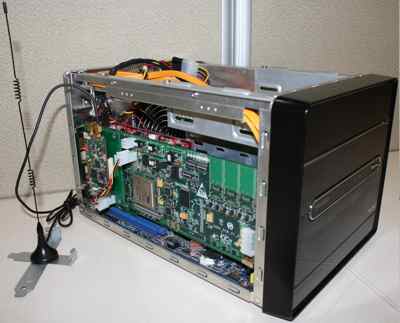| A software radio from Microsoft Research |
| Written by Harry Fairhead | |||
| Thursday, 08 September 2011 | |||
|
This is a niche news item but it provides an interesting view into another world if you are not into deep hardware/software concerns. If you know all about software defined radios, then just skip to the end of the item to learn about Microsoft Research's Sora.
Originally radio receivers and transmitters were built using analog components such as coils, capacitors and other exciting looking electronics. However, it has long been known that, just like every other analog circui,t the same job could be done using nothing but software. That is, you can build a software-defined radio (SDR). Think for a moment about the way digital sound cards took over from analog record players. Yes, you still need a speaker and a power amp to make it all work, but the really complicated signal processing is done in the sound card. A modern software radio is similar; only in place of the loudspeaker there's an aerial and the audio amplifier becomes a simple transreciever. You might think at this point that the transceiver working at radio frequency is really all you need. In an ideal world the software would do the job of the transceiver as well, with an AtoD and a DtoA converter connected directly to the aerial. In some cases even the aerial is a software construction. The real advantage of the software radio idea is when it comes to the complexity of modern radio techniques. Originally the signal you wanted to transmit was used to modulate the radio frequency (RF) signal in fairly simply ways - amplitude modulation or frequency modulation. Today we use a sophisticated mix of amplitude and phase modulation. These modulation schemes are what makes WiFi work, for example. Mostly these modulation schemes are hardwired into programmable arrays or Digital Signal Processors (DSPs) but if you want to do research into advanced radio schemes you need to be able to build custom modulation. To make this possible many radio modules have analog IQ inputs which set the amplitude of the RF signal on the I input and a quadrature (90 degrees out of phase) signal on the Q input. Put these two signals together and the result is a signal with any amplitude and phase. So now we come to the software part of the system. Take one radio module with IQ input/output and feed this into the AtoD/DtoA converters of a software radio. Now you can create any modulation scheme you care to imagine and process the signal according to the code you write. So much easier than having to build hardware. Introducing Sora
The big problem is getting the software to work at a sufficient speed to feed the data to and from the radio module fast enough. This is where the new Sora system from Microsoft Research comes in. It consists of some software and a special radio control board RCB which plugs into a PCIe slot and communicates with a radio module to pass IQ data, among other things, at up to 16.7Gbps. The software makes use of just a standard multicore CPU and modern SIMD (Single Instruction Multiple Data) to implement everything from the phsical layer up. To show that it all works, and to give some idea of what it could be used for, the Microsoft research team has implemented 802.11 WiFi using only (well very nearly) software and claims it works as well as commercial 802.11 WiFi cards. The ability to get inside the 802.11 implementation and add modifications and collect data is one huge advantage of the software approach but it could also be used to create operational modes which are not standard and not in use. The system has also been demonstrated creating a soft-LTE implementation and this could be used to make 4G phones really fourth generation. With all this background the Microsoft Research video on the topic should now make good sense.
Now we come to the bottom line - how can you get one. The software part is easy- you can simply download it from Microsoft Research. The hardware is rather more tricky. You have to buy, at anything from $500 to $2000. a radio module suitable for the frequencies you want to work with and there are a few off-the-shelf choices, WARP for example. The RCB card, however, is only available if you fill in a form verified by an academic institution and have one made locally for you at a cost of around $1500. There is also the small matter that Microsoft only allows its use for research and education purposes. So if you are a lone inventor or part of a small group planning the next stage in the communications revolution you need to look elsewhere.
More InformationAlternatives to Sora: GNU Radio project
If you would like to be informed about new articles on I Programmer you can either follow us on Twitter or Facebook or you can subscribe to our weekly newsletter.
|
|||
| Last Updated ( Thursday, 08 September 2011 ) |


